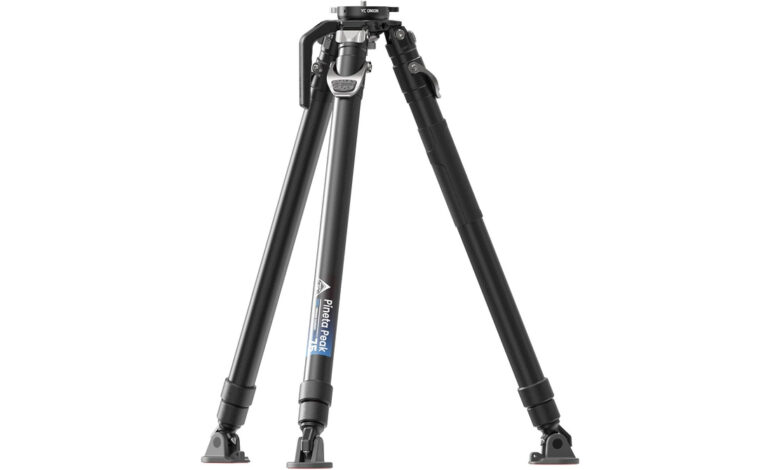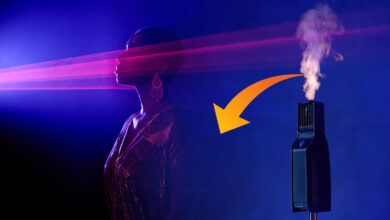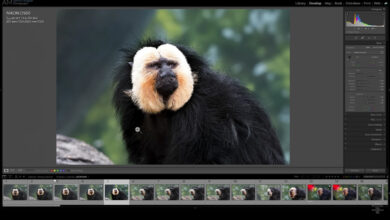Pineta Peak Tripod Review: Big, Versatile, and Great Value

Tripods can run the gamut from small tabletop-style tripods to heavy-duty production setups. The Pineta Peak system from YC Onion is on the larger end of the spectrum, but combines smart use of materials and features to make it a sensible purchase for many photographers and videographers. In this review, I’ll take a look at the system and provide some context as to why you might want to add this tripod to your kit.
Pineta Peak Specifications
The Pineta Peak Tripod certainly larger, especially if you’re more familiar with conventional tripods. To quickly review, all tripods have a trade-off between the number of leg sections, the size of those sections, and the maximum height and stability associated with them. You can get a travel tripod with 5 or 6 slim leg sections, but this will tend to shake and wobble correspondingly more.

Meanwhile, the largest tripods will have larger, fewer sections, often designed with reinforcement in mind. These tripods won’t be as portable as the smaller ones, as they can’t collapse as easily, but they can be very sturdy even with a heavy piece of kit on top. The Pineta Peak has 3 sections, with solid diameters of 39, 34, and 29mm. This makes it one of the largest tripods I’ve seen, outside of some dedicated versions. For videography, it’s in the mid-range for a “cinema” tripod, and feels smaller without the reinforcements and spreader.
The Pineta Peak, when folded, measures 30.8 inches and weighs 7.7 pounds (78 cm and 3.5 kg, respectively). As such, it’s the largest tripod in my kit, surpassing the Gitzo tripod that was previously my benchmark for stability when shooting long exposures and landscapes.
While having such a large minimum size for the legs to convert into a less flexible tripod, the YC Onion incorporates adjustable angles of 22, 52, and 82 degrees. This allows you to spread the legs out to varying degrees, bringing the minimum height down to just 6.3 inches (16cm), despite the larger footprint.

What the thick legs, very strong carbon fiber, and metal construction make up for is a huge payload capacity. YC Onion rates the load capacity at 77.2 lbs (35kg) when using the bowl head, and while I don’t have any kit that comes close to that weight, demanding applications like high magnification macro lenses or super telephoto lenses are no problem at all. Even heavy video rigs would have a hard time reaching that load capacity.
The bowl head itself is very well made, with metal throughout, bubble levels, set screws, and fine-tuning of the drag. For photographers who may not be familiar with it, the bowl head allows for quick and easy camera leveling, even if your tripod isn’t exactly level. While most commonly used for video work, I still find it useful for photography, especially when shooting panoramas or other applications where capturing the horizon is important.

The bowl heads are also interchangeable, with the YC Onion specifying cross-compatibility with popular bowl heads including the Sachtler aktiv6, aktiv8 and aktiv8T.

The tripods currently shipping have a dual function: removable rubber pads that make it easy to remove spikes on sand or ice surfaces. Additionally, the tripod has 1/4” and 3/8” threaded holes for mounting magic arms or attachments.

Pineta Peak in use
One of the biggest factors when using a tripod is how easy it is to deploy. The Pineta Peak uses YC Onion’s FEISO release system. This system uses a single locking lever on the top of the tripod to release or lock all of the tripod’s sections with a single flip. It’s ridiculous how much faster this system is than individual tripod locks, even when considering “good” deployments like Gitzo’s G-Lock, especially when deploying the tripod from its fully stowed position.

To deploy, spread the legs, flip the lock, and raise to the desired height. Flip the lock back and it will snap into place, all in about two motions. Collapse can be a little more difficult, as you may need to wiggle a leg a bit to avoid getting it stuck if you don’t drop it straight down. That said, this is absolutely the easiest setup and takedown I’ve ever had with a tripod. Adjusting the deployment is just as easy, as you can target each leg and adjust the entire length with a single flip. No more “tweaking” the length of each leg segment just to get everything dialed in!

As mentioned earlier, this tripod is capable of both great height and great weight. With the bowl head, you can hold up to 77.2 lbs at its maximum height of 61 inches, while the center pivot option can push that 72.8 inches up (though the load capacity drops significantly to 3.1 lbs). Combined with a minimum height of 6.3 inches, you can really get your camera into any position you can imagine and hold it there with precision.
I particularly like pairing the bowl head with a gimbal or panorama head. For more methodical workflows, like multi-row panoramas, the excellent stabilization is helpful and alleviates the annoyance of the size and weight of the whole setup. I also like to run it with a 3-axis or cube head for optimal precision when shooting architectural photography.

Like many creative workflows today, the Pineta Peak is designed for both photography and videography. The kits feature fluid heads, heatsinks, and video-style bowl head support, meaning the Pineta Peak will be a great choice for video production at a more affordable price point than some of the big names in video tripods.
For photographers, the dual-purpose tripod and included bowl head, along with the multi-angle support, make this a great tripod for all types of stills. I find it particularly useful for workflows that require the highest level of stabilization: long lens use, studio workflows, product photography, close-up shots, and modern PixelShift-style shooting can all benefit from a really solid setup.

While this isn’t the first tripod I’ve used while hiking, I still think it’s a well-rounded piece of kit. There are some very useful features, most notably the FEISO release system, but there are also things like interchangeable legs and included mounting points, which I’d love to see in a slightly smaller system—perhaps a 4-section version that only supports a regular tripod head and has a shorter overall length.
However, if your workflow can benefit from the features, size, and stability, I think this tripod is a great value. A basic kit, which includes the tripod and bowl head, is Available for $749 from AmazonThis is a significant savings compared to other tripods of similar size or features.
What I like
- The FEISO leg release makes it easier to set up and take down than any other tripod I’ve tried.
- Very sturdy construction makes the tripod very stable when in use
- A great combination of photography and videography-friendly features makes this a monopod solution for creators of all types who aren’t overly concerned about size or weight.
- A variety of accessories are available, such as legs, braces, bags and more, to help make this setup well supported.
What could be improved
- It only comes in one large size and many creators won’t use all of the size and capacity.
- Availability from popular US suppliers has varied, so consider looking for a kit that includes everything you want.




